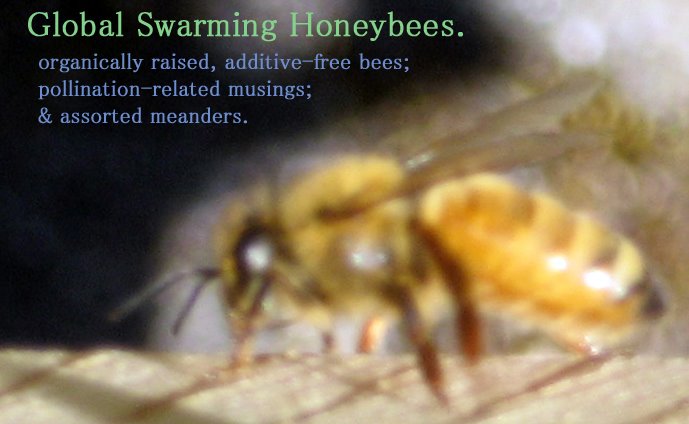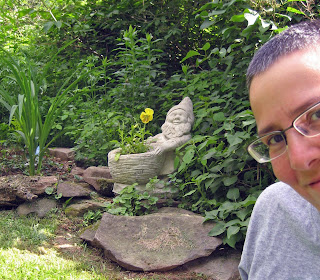 Pop quiz: Which of these objects provides a shortcut through the time-space continuum?
Pop quiz: Which of these objects provides a shortcut through the time-space continuum?
The other day, while moving some of the top bars around to improve the ventilation in Hive Orange, I inadvertently dislodged a bite-sized piece of honeycomb and couldn’t resist the temptation. I carried the sweet dollop a few feet away on the tip of my hive tool, unzipped my head veil, and unceremoniously popped it in my mouth.
Still warm from the hive, the honeycomb’s flavor imploded on my palate, a chewy, exuberantly sweet detonation of spring. Reveling in the thrill of my first hot-off-the-press honeycomb, I had the following epiphany: Honey is a time machine.
This strange substance—a product of the honeybee’s physiology, labor, and skill—is a form of liquefied time, a distillation and preservation of this particular spring in this particular place, never to be repeated.
Spring honey is a unique composition based on the botanical realities within a three-mile radius of the hive, what the weather was up to, and where the bees’ own propensities guided them during nectar collection. For while the bees have well established seasonal foraging patterns—including visits to the springtime blossoms of dandelions, berry bushes, and fruit trees—it’s also clear that choices are made and preferences expressed.
For example, I’ve heard that honeybees “love” strawberry blossoms, but all week I’ve watched these bees choose the miniscule asparagus flowers over the incisive white blossoms in a good-sized strawberry patch. The only honeybee I’ve seen in the strawberry patch was there to gather water droplets from a strawberry leaf. It looks to me like the solitary bees and flies have been pollinating the strawberries with little or no support from their honeybee brethren.
In other words, honeybees aren’t automatons going for a set type of blossom at a set moment in time. Like the rest of us, they’re making choices based on a complex and mysterious amalgam of influences unbeknownst to us, such as scent, color, shape, curiosity, a lust for something new and different, aesthetics, mood, happenstance.
Why would the honeybees select the asparagus blossoms over the perfectly lovely strawberry flowers just a few yards away? The reason might be pedestrian, its mystery squelch-able by science (e.g., the asparagus nectar is flowing more, or more alluringly—or this particular strawberry cultivar is not to the bees’ liking). But maybe there’s more to it than that: perhaps the bees prefer the shadier, sexier environment of the asparagus bed, whose branches crisscross in jungle-like effect of wild abandon. Or maybe the girls take pleasure in dangling from the tiny bell-shaped asparagus flowers—I know I would. Perhaps a wizened scout bee whose opinion they trust recommended the asparagus bed over the strawberry bed, and it’s a simple case of follow the leader. Or maybe I just heard wrong about the bees and the strawberries. To paraphrase that old-timely radio broadcast, Only the Shadow knows!
But maybe there’s more to it than that: perhaps the bees prefer the shadier, sexier environment of the asparagus bed, whose branches crisscross in jungle-like effect of wild abandon. Or maybe the girls take pleasure in dangling from the tiny bell-shaped asparagus flowers—I know I would. Perhaps a wizened scout bee whose opinion they trust recommended the asparagus bed over the strawberry bed, and it’s a simple case of follow the leader. Or maybe I just heard wrong about the bees and the strawberries. To paraphrase that old-timely radio broadcast, Only the Shadow knows!
Whatever the bees' reasons may be, their creation—honey—offers us a chance to physically commune with a lost moment in time: warm, sunny days whose place-character and botanical psychodramas the bees have taken in and transformed. This is something human beings are incapable of creating. In spite of our technological prowess, honey—that simple, ubiquitous substance produced by honeybees alone—is, to us, as unfathomable and potent as a magical elixir.
When we eat spring honey, we’re tasting time.
6.12.2007
Spring Honey: an edible time machine owned, operated (and yes, patented) by a honeybee colony near you
Labels:
asparagus,
beekeeping,
Hive Orange,
honey,
honeybee behavior,
nectar,
nectar source,
R-E-S-P-E-C-T,
strawberry,
time
Subscribe to:
Post Comments (Atom)



No comments:
Post a Comment